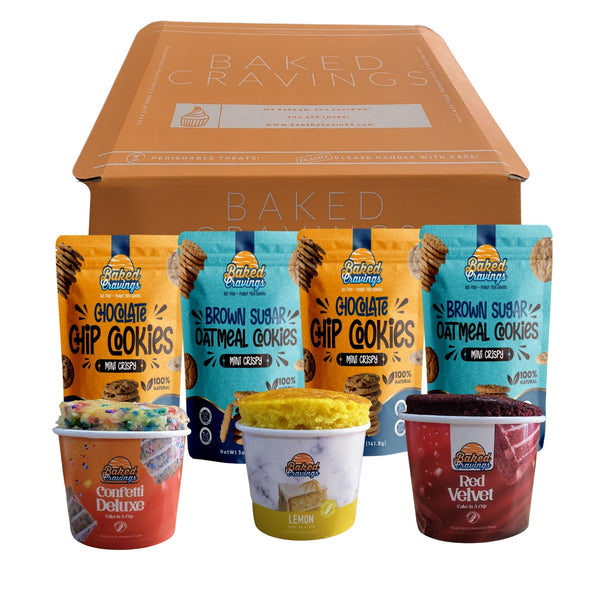Indoor Allergies: Cleaning Tips to Help "Allergy Proof" Your Home
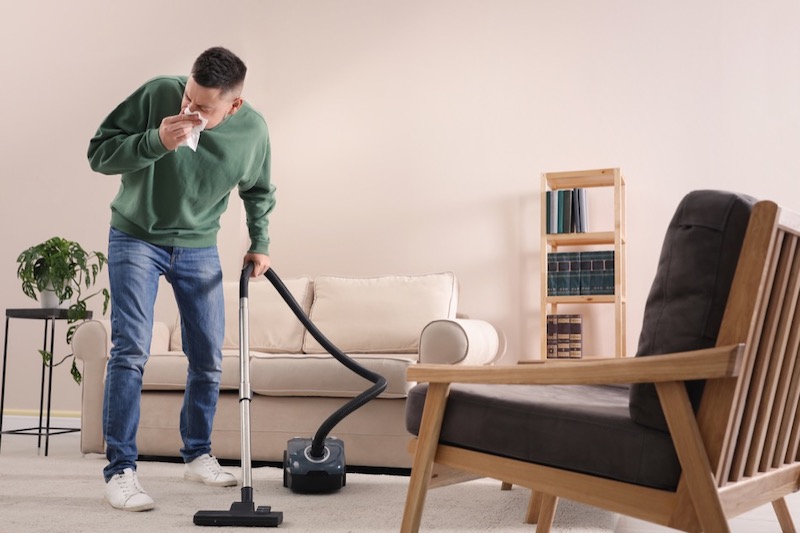 While many people think of their home as the place to escape from outdoor allergens, many allergens actually reside within the home. Dust mites, pet dander, mold spores and cockroaches can all be found inside many homes, although some types of allergens vary by region and the physical environment outdoors.
While many people think of their home as the place to escape from outdoor allergens, many allergens actually reside within the home. Dust mites, pet dander, mold spores and cockroaches can all be found inside many homes, although some types of allergens vary by region and the physical environment outdoors.
Allergens vary by room. Some find their way into the home through open windows and doors, while some are found naturally in the home because of pets, and more allergens are the result of chemicals or environmental conditions and problems like leaks and moisture intrusion.
While allergy season can feel year-round to those affected, there are many steps that can be taken to alleviate the symptoms of indoor allergies. Through effective cleaning strategies, by making small lifestyle changes, and by identifying the sources of the most problematic allergens in the home, most homeowners can control whether they're exposed to indoor allergens. If you or someone you live with has a respiratory condition or is sensitive to allergens in the home, the following tips can help. Removing allergens can increase overall comfort and improve health. Here's what you need to know.
Table of Contents
Common Indoor Allergens
To identify your home's most problematic allergens and eliminate them from your house, start by educating yourself about the types of allergens found in the home. From there, you'll be able to identify potential sources and take action. Common indoor allergens can be found everywhere in the home, from the bedroom to the basement and from the attic to the living room.
Dust Mites
Dust mites look like small bugs. These microscopic creatures can be found in many places in the home. They like humid, warm places and places where people frequently spend time. They eat skin cells and live on the sweat from humans, so they're often found in couch cushions, mattresses, carpets, furniture, blankets and easy chairs. Dust mites are most often found in parts of the home like the living room, bedroom, family room, home offices and places where people often spend time.
Dust mites are also attracted to animals like cats and dogs and can be found in the carpeting in areas where pets like to sleep. If you have a dog or a cat bed in your house, it's likely a hot-spot for dust mites.
Animal Dander
Pet dander is made up of pet skin, urine, saliva and feces. These flecks are airborne and can stay in the air for a very long time, so any house with an animal can set off a notable allergic reaction to anyone who has a pet dander allergy, even if the house has recently been cleaned. The fact that dander stays in the air makes it very difficult to remove. Pet dander must be allowed to float to the ground and then must be removed through extensive cleaning.
Even with thorough cleaning practices, getting rid of pet dander is difficult. Dander has jagged edges that clings to sofas, curtains, carpet and other forms of upholstery. Dander can even be found in buildings that have no animals, because it clings to the clothing and bodies of people who do have pets.
Do Hypoallergenic Pets Produce Dander?
More people are allergic to cats than dogs, although both types of animals can produce dander. In recent years, some types of dogs and cats have earned a reputation for being "hypoallergenic." Although some animals are less likely to produce an allergic reaction in a person with allergies, nearly all pets have some kind of grooming procedure and therefore produce dander. People who only have mild allergies and plan to keep their pet outside may be able to live with a hypoallergenic pet, but they still run the risk that their pet will trigger their allergies.
Are Hairless Pets Hypoallergenic?
Dander is not pet fur, and even hairless animals produce dander. Therefore, hairless pets are not necessarily hypoallergenic. Grooming practices and biology have more to do with hypoallergenic practices.
Mold
Mold can be found in many places around the house, including the refrigerator, walls, insulation and carpet. Mold grows best in warm, moist environments, and is often found in houses that have moisture problems. Mold spores can develop in just a matter of days following a leak or flood in the house.
Many homeowners believe that they are safe from mold unless their home develops a leak, either from the roof or their plumbing. In reality, mold can occur regardless of whether a home is experiencing a leak. Poor moisture management and drainage can lead to development of mold in the home. Some modern homes are vulnerable to mold even if they have no leak, because many modern homes don't "breathe" as well as older homes. Proper air flow dries structures and prevents mold from developing.
In addition, mold can occur inside the home because of poor ventilation and high humidity. A malfunctioning air conditioner, an air conditioner that is too large for the size of the house, lack of ventilation in the bathroom and other factors can all contribute to mold growth in the home.
Cockroaches
Cockroaches produce secretions just like pets, causing an allergic reaction in many people. The secretions that are most problematic come from saliva and excrement, which contain proteins that can hang in the air and spread like dust. Children are most vulnerable to cockroach excrement, although both adults and children are at risk in a house with cockroaches.
Cockroaches are a common problem in homes in urban areas. Cockroaches can exacerbate asthma and other respiratory conditions. While keeping a clean house can help keep these allergies at bay, getting rid of cockroach excrement can be especially hard because cockroaches can hide in so many difficult-to-reach areas. The only way to truly protect people in the household from cockroach allergies is to eliminate cockroaches from the home.
Indoor Asthma Triggers
Allergic asthma is a type of asthma that is triggered by allergens. People experience asthma reactions when exposed to allergens because their immune system believes allergens to be harmful. The immune system responds by releasing a substance that triggers inflammation and causes swelling of the airways.
The best way to control asthma triggers is to first identify what those triggers are, then to limit exposure to those triggers. Each person affected by asthma triggers must eliminate those triggers on a case-by-case basis, working with their doctor to develop a plan to manage symptoms and exposure. Indoor asthma triggers can be especially dangerous because the extreme response of the body can limit breathing.
Patients must work with their doctors to ensure that their symptoms are managed and to ensure they have the proper medications on hand to alleviate symptoms (inhaler, etc), in the event that the patient suffers from an asthma attack. If you suffer from allergic asthma, work with your physician to stay safe.
Symptoms of Indoor Allergies
Although each person is different and which allergens are triggers can vary from one person to the next, the symptoms of indoor allergies are fairly consistent from one person to another. Common symptoms of indoor allergies include:
- Stuffy nose
- Itchy eyes
- Sneezing
- Wheezing
- Cough
- Tightness in the chest
- Scratchy throat
Some of these symptoms are similar to symptoms that people experience when they have a cold or the flu. However, most people can tell the difference between allergy symptoms and other types of illness in the following ways:
- Symptoms may change in different environments; leaving home or leaving the geographic region may alleviate symptoms.
- Symptoms may come and go depending on the time of year.
- Symptoms are consistent whenever exposed to certain types of allergens.
Many people find out they have allergies by getting an allergy test with a physician. If you believe that you have allergies, contact your doctor to get tested. Your doctor can tell you whether you have allergies and should also be able to tell you what you're allergic to. Once you have this information, you can make changes in your environment and behaviors to help you curb symptoms and avoid exposure to allergens.
How to Manage Symptoms of Indoor Allergies
The best way to prevent symptoms is to avoid exposure to the allergen in the first place. However, there are other treatments that can help curb symptoms after exposure has occurred. There are many medications in pharmacies that can treat allergies.
- Over-the-counter antihistamines. Antihistamines fight the effects of the histamine released by the body during an allergic reaction, thus reducing the symptoms.
- Decongestants. Decongestants reduce swelling in the nasal passages.
- Prescription medications. Prescription medications vary depending on the prescription and the allergy being treated.
Although many over-the-counter medications can be effective against some symptoms, people who experience severe symptoms should work with their physician to obtain prescription medications. Allergy immunotherapy treatments can also be very effective, but they are only available to people who see their physician. These treatments work by exposing the immune system to small doses of the allergen, thus reducing the immune response. Allergy immunotherapy treatments take about 3 years to complete and require periodic visits to the doctor for allergen shots.
Non-Allergic Triggers
Sometimes people who have indoor allergies also experience strong reactions to particles that are not from natural allergens but from household chemicals and products. People who react strongly to non-allergic triggers must be especially careful of the types of products they use in their home. In addition, people may also be sensitive to chemicals and products they experience in the workplace and in consumer settings. Common non-allergic triggers include:
- Plug-in air fresheners
- Cleaning products
- Tobacco smoke
Starting the car in the attached garage can allow gas into the home that can also trigger allergies and asthma symptoms. People with sensitive lungs who want to protect themselves can use natural cleaning products (vinegar, baking soda, and so on) and avoid using scented air fresheners. Most important, people who have respiratory sensitivities and allergies should not smoke and should avoid contact with tobacco smoke.
What Are Home Allergen Tests?
Home allergen tests are affordable, at-home test kits that you can do at your house and then send the results to a lab for analysis. Home allergen tests identify allergens that exist in your home. These tests are designed to be user-friendly and come with everything you need to perform the test.
Once you know the results, you can find the cause of those pollutants in your home. Test kits can also help you identify other issues that could be affecting the environment in your home. If you're sensitive to allergens, you may also be extra sensitive to other common household toxins. These test kits can help keep your living environment safe and give you the information you need to eliminate potential poisons from your house.
Organic Vapor Test Kits
These test kits identify volatile organic compounds (VOCs). VOCs come from chemicals like cleaning products and carpeting. VOCs are believed to cause short-lived problems like headaches and nausea or much more serious health problems, like cancer. A common cause of VOCs is interior paint. Fortunately, many paint companies now produce low-VOC paint.
Mold Test Kits
These kits identify mold found in parts of the home like the bathroom, basement, attic and crawl space. Mold test kits are especially useful for homeowners who have recently identified a leak or moisture problem in the home.
Lead Test Kits
Lead dust, usually the result of lead-based paint, is common in older homes. Lead dust kits can help homeowners determine whether their home has toxic dust in their house. If so, remediation may be necessary. These test kits are most important in households where children are present, as they can be especially vulnerable to the toxins in lead-based paint.
Dust Mites
For homeowners who have an allergy to dust mites, this test kit will help them identify which parts of the house are most impacted by dust mites. Dust mites can be difficult to eliminate, but it helps to start by finding the rooms where they are most prevalent.
Any homeowner can purchase these test kits for themselves. Purchasing many test kits all at once can be expensive, so you'll have to decide which test kits are most helpful and which test kits are most likely to produce results in your home.
Managing Allergens Within the Home
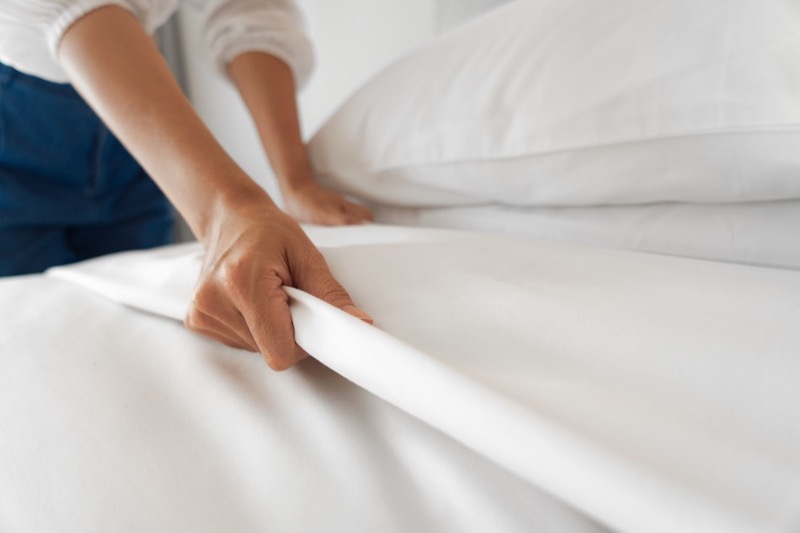
Different types of allergens can be found in different places in the home, depending on the activities that take place in those parts of the home. Knowing what kind of allergens are found in what parts of the home can help you decide which actions to take to eliminate those allergens. Once determining where the allergen hot spots are in your home, you can take steps to mitigate them.
Allergens found in the bedroom are different from the allergens found in the bathroom, which are also different from the allergens found in the basement. This is because allergens form based on the environment in that part of the house.
Bedroom
You probably spend about one-third of your life in the bedroom. Dust mites are one of the most common allergens found in the bedroom. With all that time spent in the presence of dust mites, it's important to take steps to reduce your exposure. Keeping this space clean, dust-free and organized can help you stay healthy and avoid the worst allergy symptoms.
Dust mites are not seasonal, so exposure to dust mites can go on all year long. To avoid never-ending exposure to this allergen, keep your bedroom clean and organized. Declutter on a regular basis so dusting becomes easier. Establish a regular cleaning schedule and stick to it to prevent dust mites from building up in any one part of the house.
Eliminate Dust Mites in the Bed
The bed is a favorite place for dust mites to hang out. It's warm, relatively humid, and there's a lot of food sources in the bed (dead skin cells) for dust mites to munch on. Although fighting dust mites may feel like a losing battle, there are things you can do to eliminate this invisible enemy in the sheets.
Use Dust Mite Proof Covers
Dust mite proof covers are available for pillows, mattresses, comforters and box springs. These covers help keep dust mite activity in the bed to a minimum. Studies show that people with asthma need less asthma medication when using dust mite proof covers, so these products really do work. However, just because dust mite covers are in use doesn't mean that it's ok to relax on cleaning or organizational practices. Only by staying vigilant can you truly keep dust mites out of your bedroom.
Clean Your Bedding Regularly
Wash your bedding on a regular basis to eliminate dust mites (and their food source). Most people wash their sheets on a regular basis but forget to wash other parts of the bed like their pillows, comforter, extra blankets, and mattress.
- Wash pillows every 6 months
- Wash your comforter quarterly
If you own a fabric mattress, sprinkle it with baking soda and allow the baking soda to sit for 15 minutes. Then, use a vacuum with a HEPA filter to remove the baking soda. Do this quarterly. If you own a memory foam mattress, vacuum the mattress but do not use baking soda.
Follow all washing instructions on your bedding. Read the tags and leave tags on for future washings. Avoid washing your mattress with liquid; if you do, allow it to dry fully before putting it to use once again.
Some people help eliminate dust mites from their bedroom by running a dehumidifier regularly. A humidity of 35% or lower is enough to reduce dust mite populations. However, you may find a relative humidity of 35% to be uncomfortable, and running a dehumidifier regularly can be expensive. You'll have to make this decision for yourself.
Vacuum Regularly
Create a vacuuming schedule to regularly vacuum your entire bedroom from end to end. Create your schedule in a standard paper calendar, or download a smart app that will set reminders in your phone. When vacuuming your bedroom, use a hose attachment to reach out-of-the-way places under the bed and in corners. Vacuum parts of the room like upholstered chairs, curtains or drapes, blinds and the dark corners of the closet.
- Declutter the bedroom to simplify vacuuming.
- Keep all clutter off the floor.
- Contain personal items in contained bins that are easy to move and easy to clean.
Carpeting harbors dust mites easily, and hardwood floors do not. It’s easier to get a bedroom with hardwood floors cleaner, so many homeowners opt to remove the carpeting from their bedroom. However, because hardwood floors have no hiding places for dust mites, they need to be cleaned more frequently than carpeting or dust bunnies will form on the surface.
If you choose to leave carpeting in your bedroom, have it professionally shampooed on a regular basis. If you’re installing carpeting in your bedroom, choose low VOC carpeting to prevent the release of VOC gasses into the room.
Keep Windows Clean
Windows are another source of dust and must be cleaned regularly. Use washable curtains in your bedroom and wash them every 6 months. To remove dust from blinds, wipe the dust off with a microfiber cloth, first on one side, then on the other. Spritz a clean microfiber cloth with a solution of water mixed with vinegar, then wipe down the blinds again.
Next, clean the windows. This is best done at a time when the sun is not shining through the windows, especially if the weather outside is hot. Heat can cause the cleaning product to evaporate quickly before it’s distributed across the glass, causing streaks.
- Vacuum the windowsill to remove dust and dirt around the window.
- Spritz the window with cleaner.
- Wipe down the window glass with a dry microfiber cloth.
Some people choose to use a squeegee when cleaning their windows, but squeegees used indoors spray water on the windowsill and floor below, creating a mess. Standard glass cleaner works well, but homemade glass cleaners made from vinegar and water work as well. To make your own glass cleaner, mix one part water and one part vinegar.
Declutter
Declutter your bedroom to make it easier to clean and eliminate places where dust mites exist. Start by removing anything that does not need to be in the bedroom. This includes anything that can be placed in another part of the house or in a storage facility. Seasonal clothes, holiday decorations, old bills and old magazine subscriptions don’t belong in the bedroom. Recycle what can be recycled, give away what you don’t need anymore, and relocate what you do need but would like to take out of the bedroom.
- Create separate piles for items that need to be donated, given away, thrown away, recycled and moved.
- Find containers for clothing items on open shelving.
- Remove extra pieces of furniture.
- Remove knick-knacks.
- Put all shoes in a shoe rack with no shoes on the floor.
- Clear the floors of the closet or store items in contained bins that can be easily moved.
- Place like-items together for easy location.
- Put labels on bins to make them easier to find later.
When decluttering, make a rule that anything you haven’t worn or used in one or two years (you set the quantity of time) should be eliminated. Struggling with sentimental items? Keep what you want, but consider giving some sentimental items to family and people close to you. This keeps sentimental items within reach but also helps you keep a cleaner, safer house.
Protect and Filter Bedroom Air
Dust mites like warm, damp conditions. If your bedroom is warm and humid most of the time, you could be creating the perfect conditions for dust mites. Use your air conditioner throughout the summer to reduce humidity, and if you don’t have an air conditioner, consider the use of a dehumidifier.
HVAC systems use air filters to clean the air coursing through the ducts. Air filters come with MERV (Minimum Efficiency Reporting Value) ratings that measure the filter’s ability to filter out small particles. MERV 11 through 13 filters can remove particles as small as viruses and bacteria. Use a MERV 11 or 12 filter to clean the air in your home. The EPA recommends changing your air filter at least every 3 months, but if you have sensitivity to particles in the air, check the air filter monthly and replace it when it starts to look dirty.
Steps to Change Your Air Filter
- Turn off the HVAC system (air conditioner and furnace).
- Remove the air filter from the slot between the blower and the return air duct.
- Insert the new air filter into the slot.
- Turn on the HVAC system.
If you can’t find the air filter, check with the instruction manual for your HVAC system.
Living Room
Living rooms are the place where family gatherings and gatherings with friends take place. This makes living rooms an important place to manage allergens, even if people in your household don’t experience allergies themselves. To make your house a safe and comfortable place for people to spend time, keep your living room clean as possible and free from mold, dust mites and other airborne toxins.
- Test your living room for presence of toxins and allergens.
- Find sources of the allergens.
- Make changes to the living space, behavioral and lifestyle changes where appropriate.
Manage Your Furniture
Many of the dust mites in the living room reside in the furniture. Fabric couches and chairs in particular harbor dust mites that are very difficult to remove. Simple vacuuming often does not eliminate the dust mites, which makes keeping up with cleaning very challenging.
The most effective thing that you can do to eliminate dust mites from your living room furniture is to replace fabric couches and chairs with furniture made of leather, wood, metal or plastic. If you’re not able to replace your furniture, clean your upholstered furnishings regularly following the manufacturer’s instructions. Fabric furniture will have cleaning codes that indicate what kind of cleaning products can be used on that piece of furniture.
- W: water-based cleaner only
- S/W: solvents and water-based cleaners
- S: solvents only
To clean your upholstered furniture, follow this procedure:
- Sprinkle baking soda on the upholstery.
- Allow the baking soda to sit on the upholstery for 15 minutes.
- Vacuum the baking soda from the upholstery.
- Wipe down cushions with a damp rag with manufacturer-approved cleaning agent.
- Dry the upholstery with a dry towel.
- Prop up the cushions until they dry fully.
Cleaning your upholstery at least every 6 months can help keep dust mites out of your living room. If you're considering replacing your upholstered furniture with an allergy-friendly material, replace the furniture one piece at a time over a period of months to spread out the expense and make the process more affordable.
Limit Indoor Plants
Mold can grow in indoor soil, leading to the spread of mold spores throughout the house. You can limit problems originating with indoor plants by limiting the number of indoor plants kept in the house. Other ways to prevent mold from growing in the soil include:
- Keep plants in dry parts of the house.
- Space plants apart to ensure good air flow between leaves.
- Water plants on a regular basis, but allow the soil to dry before re-watering.
- Use potting soil, which is designed to drain well, rather than garden soil.
Inspect your plants for mold growth in the soil. Watch for white, fuzzy mold growing on the surface of the soil, and soft, fuzzy mildew on the surface of the leaves.
If you find mold growing on the soil of your plants, remove the mold by treating the soil and repotting the plant.
- Dry out the soil.
- Spray the soil with fungicide.
- Repot the plant in sterile potting soil treated with anti-fungal additive.
Mold spores can travel from one plant to another, so if you find mold growing in the soil of one plant, treat the soil from other plants, even if you don’t see evidence of mold in the soil of any other plants.
Consider Your Fireplace
Wood smoke contains small particles that can irritate the eyes and respiratory system, causing problems like runny nose, burning eyes and even illness. Small particles from wood-burning fires can fill the lungs and may even enter the blood stream. Wood smoke also contains toxic substances like formaldehyde and methane.
Limit the use of your wood-burning fireplace and wood-burning stove to prevent particles from smoke negatively impacting your indoor air quality. Maintain your chimney by having it inspected by a certified chimney professional on an annual basis, or more often if you use your chimney daily.
Burn seasoned firewood only. Never throw water on your fire to put the fire out. Instead, separate the logs and allow the fire to burn down. Close the glass doors when the fire is finished burning.
If your chimney is very old, contact a chimney professional about installing a new fireplace insert. Fireplace inserts made after 1992 are designed to be safer and more efficient for reduced exposure to firewood smoke in the home. If you stop using your fireplace in the late spring, do not use your chimney again in the fall until it has been inspected by a professional, as birds can build nests in chimneys, causing smoke to flow into the home.
Kitchen
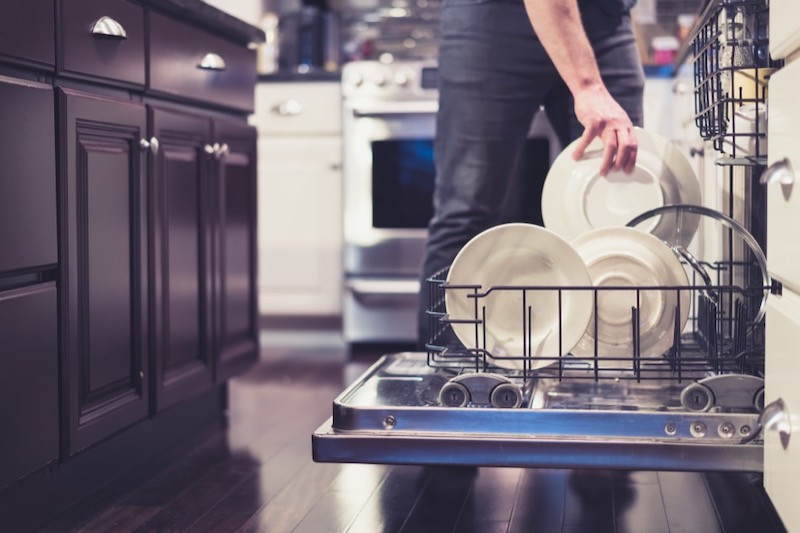
Mold, mildew and cockroaches are the primary allergens that people experience in the kitchen. Cleanliness, proper ventilation and good food safety practices are the key to keeping allergens out of the kitchen. By establishing good cleaning routines and by maintaining a safe overall environment, you can reduce exposure to allergens. Testing the kitchen with a testing kit is one way to identify the allergens found in the kitchen.
fDo the Dishes
Do the dishes every night before bed or multiple times throughout the day. Do not allow dirty dishes to sit in the kitchen overnight. Always dry dishes before putting them away in the cabinets, and do not allow wet dishes to sit against one another for long stretches of time.
When washing dishes, use a rubber food scraper to scrape food off dishes and into the trash. Do not allow food to go down the dish drain, as it may sit in the drain for long stretches of time, leading to mold and smells.
Wash dishes in warm-to-hot water with dish soap and a clean dish rag. Replace your dish rag after cleaning up every meal.
If using your dishwasher, remove dishes from the dishwasher after it has finished running, then dry and put them away. If you use your dishwasher on a regular basis, clean the filter in the bottom as recommended by the manufacturer. Some dishwashers have self-cleaning filters that never need cleaning, while other dishwashers have filters that need to be cleaned monthly. Read the owner’s manual for your dishwasher for guidance on when and how to clean your dishwasher filter.
Keep Food Organized and Safe
Food left in the refrigerator for a long time can become moldy. Mold in the refrigerator can spread mold to other food items. Food mold is an allergen that can make some people ill. Maintaining an organized refrigerator can prevent the spread of mold from one food item to another. Staying organized also makes it easier to clean the refrigerator.
Keep all food stored in tight containers. Know which types of food can be left out and which types of food cannot. Invest in many small containers for storing individualized portions of leftovers. Label containers of leftovers with the type of food and date when it was packed for easy identification of foods that need to be thrown out.
Clean out your refrigerator once per week. To clean out your refrigerator, empty the entire shelf, clean the shelf with a paper towel spritzed with multipurpose cleaner, then replace the foods that have not expired.
Mayo Clinic suggests keeping leftovers for only three or four days. If you produce a lot of leftovers throughout the week, make a schedule for consuming leftovers (suggestion: institute “leftover night” for dinners twice per week), or clean out your refrigerator twice per week.
Take Out the Trash
Trash itself can contain allergens that can impact your home’s indoor air quality. Take out the trash every evening and any time you’re leaving on a trip. Set a schedule and assign someone to clean the trash each day of the week, or assign this duty to one person in the household to ensure the work is done consistently.
Clean out your trash bin weekly or every other week as needed. Use water mixed with a little bleach to clean out your trash bin, or spray the bin with an antibacterial, multipurpose cleaner. If you own a trash compactor, follow manufacturer instructions regarding use and cleaning.
Recycle whenever possible to avoid filling landfills. Familiarize yourself with the rules of your local recycling service, and only recycle materials that your recycling facility will accept. Clean all materials (like cans and bottles) before placing them in your recycling bin. Do not attempt to recycle materials that are contaminated with food.
Deep Clean and Air Out
Hopefully you clean your kitchen superficially on a daily basis, and clean it well on a weekly basis. Every other week, deep clean your kitchen. Start by gathering materials.
- Dust mop
- Sponges
- Bucket
- Vacuum
- Stepladder
- Cleaning cloths
- Oven cleaner
- All-purpose cleaner
- Pillow case
- Vinegar
- Broom
Start by cleaning the walls with a dish rag dampened with water and a mild detergent. Pay close attention to walls near the trash bin. Dust the corners with a dry microfiber towel. Clean the ceiling fan with a pillow case by wrapping the pillow case around each blade of the ceiling fan, then turn the pillow case inside out and shake the pillowcase outside. Wash curtains and blinds as indicated in sections above. Use oven cleaner to clean your oven, following practices outlined in the manufacturer instructions. If your oven cleaner requires the cleaner to soak for a period of time, spray the cleaner early on in the cleaning process, clean another part of the kitchen, then return to the oven to finish the job.
Unplug your refrigerator, then vacuum the coils. Some refrigerators have coils on bottom, while others have coils in the back. Locate your refrigerator’s coils by checking in your owner’s manual. Don’t forget to plug your refrigerator back in once you're done!
Clean accumulated grease on the cabinet, stove and small appliances with a combination of vinegar and water. Unplug small appliances before cleaning them. To clean the microwave, fill a bowl with water and a splash of vinegar, then put the bowl in the microwave and heat it up until it boils. Remove the bowl and wipe down the inside of the microwave with a clean microfiber cloth. Clean the turn table separately in the sink.
To clean the dishwasher, run it empty with a splash of vinegar in the soap dispenser. Clean your garbage disposal by pouring baking soda and warm water into the unit and running on high for several seconds. Spray your counters with multipurpose cleaner, then wipe the counters. Mop your floors with hot water and floor cleaner.
Tip: Use the vent during cleaning and after each meal to reduce humidity and control particles in the air.
Bathroom
While the bathroom may not attract dust mites in large numbers, it can attract other allergens like mold and cockroaches. Wash your towels, shower and bathmats regularly, and follow the tips below. As in the kitchen, use vents in your bathroom to improve air circulation. This enables the walls to dry after using the shower and also prevents condensation on the walls from promoting growth of mildew.
Choose the Right Wall and Floor Materials
Some building materials are more mold-resistant than others. When remodeling or designing a bathroom, choose materials that resist mold growth.
- Ceramic tile is easy to clean and resists mold growth, but keep the grout between tiles sealed to prevent mildew from growing on the grout.
- Vinyl is easy to clean and requires no grout; it’s also inexpensive for homeowners on a budget.
- Cork is a mold-resistant product that’s also eco-friendly; work with a contractor to ensure that the tiles are installed properly.
- Hardwood is also an eco-friendly product, but it must be properly maintained and refinished periodically or it will become damaged.
Keep It Ventilated
Every bathroom needs a vent. If one of your bathrooms does not have a proper vent, have one installed by a contractor. Most older vents must be turned on and off by hand, and some vents are wired to the light fixture, so that any time the light is on, the vent is turned on as well. Although this is one way to ensure that the vent is used regularly, there are disadvantages to wiring the light and vent together. Namely, vents can be loud. Running the vent while the light is on makes holding conversations difficult.
Modern bathroom vents have new solutions that make using the vent convenient and energy efficient.
- Ultra-quiet vent options make it easy to have conversations in the bathroom while the vent is in use.
- Smart vents measure humidity and turn on when humidity levels are high.
- Smart vents also turn on and off automatically and do not require anyone to turn a switch.
Remove Mold Immediately
Mold in the bathroom can endanger the health of people who are allergic to it, so when mold is identified in the bathroom, it needs to be removed as soon as possible. Vinegar is known to kill 80% of the different types of mold found in the home and is widely considered to be a better option than bleach for removing mold in many situations.
Spray moldy surfaces with straight vinegar. Leave the vinegar on those surfaces for approximately one hour. To prevent the vinegar from evaporating, cover the surfaces with plastic wrap while it is sitting. Scrub the mold away with a scrub brush. Use this method to remove mold from the shower, tub, toilet and sink.
It’s generally safe to remove mold on your own if you’re cleaning non-porous surfaces and the mold is surface-level only. Call a professional to remove the mold from your house when it is on porous surfaces (like drywall), especially if there is evidence that the mold is deep into the structure of the home.
Basement
Basements are especially vulnerable to mold because they’re cold, damp and dark. Basements can also harbor insects, like cockroaches, which are drawn to these spaces for the moisture, seclusion and safety. Inspect your basement on a regular basis to identify potential mold growth.
If you identify mold growth in your basement, work with a contractor to eliminate the conditions that lead to the mold growth. Water intrusion, poor ventilation and poor drainage can all contribute to mold on the walls, floors and in the ceiling. Mold growth is often a symptom of a larger drainage problem. If the mold is extensive, a remediation company and repair professional may be required to help fix the problem.
Find and Fix Leaks
Although most people assume that basements are naturally wet, the worst moisture problems in basements occur because something is wrong with the structure. Moisture problems cause mold and contribute to pest infestations, making basements dangerous places for people with sensitivities.
Improper Sealing of Windows and Doors
Windows and doors must be sealed. Windows and doors that lead into the basement are often close to the ground and therefore already high risk for leaks. If the seals around the windows and doors deteriorates, then this can lead to water problems, causing mold. Hire a contractor to repair seals, or caulk the cracks between windows and doors yourself.
Pooling Water Around Foundation
Poor drainage on the property can lead to leaks through the walls of the basement, especially if there are cracks in the walls. Drainage can be improved with the installation of a sump pump or a French drain around the basement. These installations are complex, so hire a contractor to do the work.
High Humidity
Sometimes basements are just humid, which can lead to condensation on the walls. Install a dehumidifier to alleviate moisture.
Plumbing Leaks
Most plumbing runs through the basement. Old plumbing especially can develop leaks; in basements, these leaks may go for days or weeks without being noticed.
Sump Pump Problems
A sump pump that is too small or in disrepair may not be able to keep up with moisture intrusion in your basement. Have your sump pump inspected by an expert, and replace it if it cannot be fixed.
Identify Foundation Damage
Foundation damage can lead to water intrusion, causing mold. Large cracks in the foundation can be a sign of a problem that needs immediate repair, but even small cracks in the foundation enable water to seep out of the soil and into the basement, especially during storms.
Inspect your foundation on a regular basis, especially if you’ve been getting water intrusion. Cracks larger than a quarter of an inch wide are an indication of serious foundation damage. Contact a structural engineer as soon as possible to have these cracks evaluated.
Other signs of foundation damage include:
- Interior sheetrock cracks
- Uneven floors
- Rotten wood
If the cracks in your foundation are smaller than a quarter of an inch wide, they may not be indicative of a foundation problem, but can still lead to water intrusion. Fill these cracks with urethane caulk. Urethane caulk comes in caulk guns. Don’t touch the urethane caulk with your bare hands, as it sticks to skin and is very difficult to remove. Keep a rag with paint thinner on it on hand to remove caulk that is stuck to hands, clothes and other things.
Entire House
Allergens can be found all over the house and not just in the parts addressed above. These general best practices will help you control allergens and maintain safe indoor air quality.
Monitor and Manage Humidity
Use a hygrometer to measure the relative humidity in your home. If the humidity rises above 50%, run your air conditioner, use a dehumidifier and turn on vents in rooms like the kitchen and bathroom. If humidity is a regular problem in your home, even if you’re running the air conditioner, have your air conditioner inspected by an HVAC professional. It may be that your unit is not working properly, or that it’s incorrectly sized for your house.
Guard Against Pollen
Keep windows closed and run your HVAC system when pollen counts are high. Use a HEPA air purifier to eliminate pollen from your home and clean your air. Contact an HVAC professional to clean the ducts in your home and eliminate pollen from the air.
Control Pests
Work with a pest control company to get regular pest control treatments and eliminate pests in your home. Maintain a clean house and fix all plumbing leaks as soon as they develop to make conditions less favorable for pests like cockroaches. Store trash bins away from your home.
Keep Your Pets Clean
Get your pets regularly groomed by a professional. Clean your pet’s bedding and toys regularly, especially your pet’s bed and/or favorite blanket.
Protecting Your Household
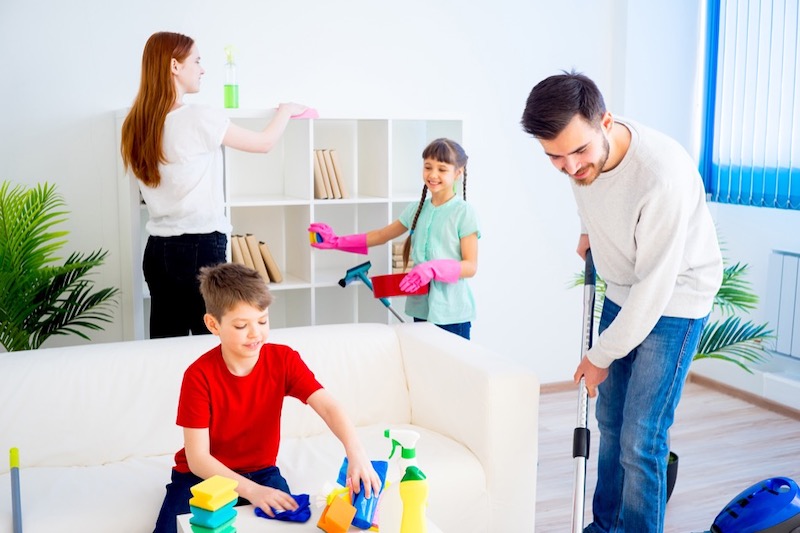
Allergies are a fact of life for many people, but you can control and may even be able to alleviate your allergy symptoms by making changes to the way you keep your house. By allergy-proofing every part of your home, especially your primary living spaces, you and your loved ones can breathe easier.
Clean often. Clean deeply. Maintain a cleaning schedule. Inspect your home regularly for signs of mold, mildew, pests and other problems. If you find evidence of a problem, like mold or mildew, take action. With this knowledge and these tips in mind, you can get started today to relieve your indoor allergy symptoms.
Other Helpful Resources
- https://www.epa.gov/mold
- https://www.epa.gov/indoor-air-quality-iaq
- https://www.aafa.org/control-indoor-allergens/
- https://www.cdc.gov/asthma/triggers_indoor.html












